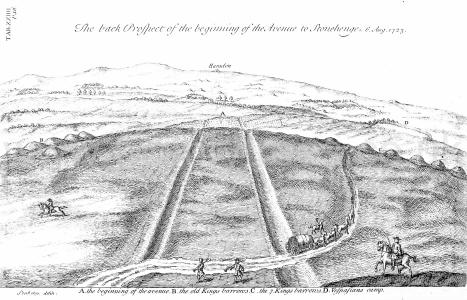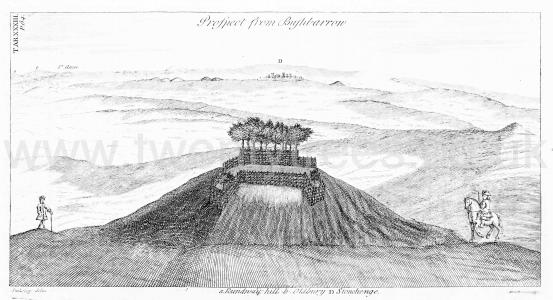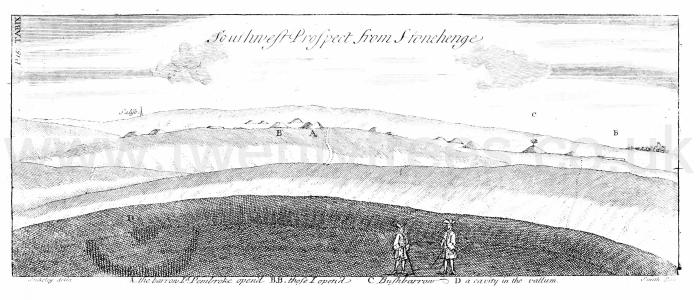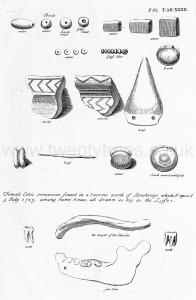Stonehenge Chapter X
Stonehenge Chapter X is in Stonehenge A Temple Restored To The British Druids By William Stukeley.
Of the barrows, or Sepulchral tumuli about Stonehenge. Generally is in groups, which are family burial places; and in sight of Stonehenge. They are single burial places. How the body is posited. What has been found in digging into these barrows
I come in the last place to speak of the barrows, observable in great numbers, round Stonehenge. We may very readily count fifty at a time, in sight, from the place; easily distinguishable: but especially in the evening, when the Hoping rays of the sun shine on the ground beyond them. These barrows are the artificial ornaments on this vast and open plain. And it is no small entertainment for a curious person, to remark their beauties, their variety in form and magnitude, their situation. They are generally of a very elegant campaniform shape, and done with great nicety. There is likewise a great variety in their shape, and turn, and in their diameters, in their manner of composition. In general, they are always upon elevated ground, and in sight of the temple of Stonehenge. For they all regard it. This shews, they are but superficial inspectors of things, that fancy from hence, great battels on the plain; and that these are the tumultuary burials of the plain. Quite otherwise; they are assuredly, the single sepulchres of kings, and great personages, buried during a considerable space of time, and that in peace. There are many groups of them together, and as family burial places; the variety in them, seems to indicate some note of difference in the persons there interr'd, well known in those ages. Probably the priests and laity were someway distinguish'd; as well as different orders and stations in them. Mod; of the barrows have little ditches around, extremely well defin'd. In many is a circular ditch 60 cubits in diameter, with a very small tumulus in the center. 60 or even 100 cubits is a very common diameter in the large barrows. Often, they are set in rows, and equidistant, so as to produce a regular and pretty appearance, and with some particular regard to the parts of the temple, the avenues, or the cursus. For instance, where the avenue begins at the first elevation, from Radfin ford, advancing towards Stonehenge, seven large and fiat old barrows are on the right hand of the avenue, towards the east: end of the cursus, seven large barrows of a newer shape, are on the left hand: bosh these groups before spoken of, are plac'd in a similar manner, in regard to the avenue, and as wings or openings to it. Upon every range of hills, quite round Stonehenge, are successive groups of barrows, for some miles: and we may even observe, that great barrow by Lord Pembroke's park at Wilton, which I call the tomb of Carvilius, is set within view of Stonehenge.
Table XXIV. The back Prospect of the beginning of the Avenue [Map] to Stonehenge. A. the beginnings of the avenue. B. the old Kings barrows C. the 7 Kings barrows D. Vespasian's Camp [Map]. [Haradon Hill is speculatively identified as what is now known as Telegraph Hill [Map]] on which there are numerous tumuli.

Table XXXIII. Prospect from Bushbarrow [Map]. a. Roundway Hill. b. Oldbury D. Stonehenge.

In 1722, my late Lord Pembroke, Earl Thomas, who was pleas'd to favour my inquiries at this place, open'd a barrow, in order to find the position of the body observ'd in these early days. He pitch'd upon one of those south of Stonehenge, close upon the road thither from Wilton: and on the east side of the road. 'Tis one of the double barrows, or where two are inclos'd in one ditch: one of those, which I suppose the later kind, and of a fine turn'd bell-fashion. It may be seen in Plate IX. On the west: side, he made a section from the top to the bottom, an intire segment, from center to circumference. The manner of composition of the barrow was good earth, quite thro', except a coat of chalk of about two foot thickness, covering it quite over, under the turf. Hence it appears, that the method of making these barrows was to dig up the turf for a great space round, till the barrow was brought to its intended bulk. Then with the chalk, dug out of the environing ditch, they powder'd it all over. So that for a considerable time, these barrows must have look'd white: even for some number of years. And the notion of sanctity annex'd to them, forbid people trampling on them, till perfectly fettled and turf'd over. Hence the neatness of their form to this day. At the top or center of this barrow, not above three foot under the surface, my Lord found the skeleton of the interr'd i perfect, of a reasonable size, the head lying toward Stonehenge, or northward.
Table IX. Southern Prospect from Stonehenge. A. the barrow Ld Pembroke opened [Map]. B.B. [Map] those I opened. C. Bushbarrow [Map] D. a cavity in the vallum.

The year following, in order to prosecute this inquiry, by my Lord's order, I begun upon a barrow north of Stonehenge, in that group south of the cursus. 'Tis one of the double barrows there: and the more easterly, and lower of the two: likewise somewhat lefs. It was reasonable to believe, this was the sepulture of a man and his wife: and that the lesser was the female: and so it prov'd, at lead: a daughter. We made a large cut on the top from east to weft. After the turf taken off, we came to the layer of chalk, as before, then fine garden mould. About three foot below the surface, a layer of flints, humouring the convexity of the barrow. These flints are gather'd from the surface of the downs in some places, especially where it has been plow'd. This being about a foot thick, rested on a layer of soft mould another foot: in which was inclos'd an urn full of bones. This urn was of unbak'd clay, of a dark reddish colour: crumbled into pieces. It had been rudely wrought with small mouldings round the verge, and other circular channels on the outside, with several indentures between, made with a pointed tool, as depicted in Plate XXXII. where I have drawn all the forts of things found in this barrow. The bones had been burnt, and crowded all together in a little heap, not so much as a hat crown would contain. The collar bone, and one fide of the underjaw are grav'd in their true magnitude. It appears to have been a girl of about 14 years old, by their bulk and the great quantity of female ornaments mix'd with the bones, all which we gather'd. Beads of all forts, and in great number, of glass of divers colours, mold yellow, one blak. Many single, many in long pieces notch'd between, so as to resemble a string of beads, and these were generally of a blue colour. There were many of amber, of all shapes and sizes, flat squares, long squares, round, oblong, little and great. Likewise many of earth, of different shapes, magnitude and colour, some little and white, many large and flattish like a button, others like a pully. But all had holes to run a firing thro', either thro' their diameter, or fides. Many of the button fort seem to have been cover'd with metal, there being a rim work'd in them, wherein to turn the edge of the covering. One of these was cover'd with a thin film of pure gold. These were the young lady's ornaments. And had all undergone the fire: so that what would easily consume fell to pieces as soon as handled. Much of the amber burnt half thro'. This person was a heroin, for we found the head of her javelin in brass. At bottom are two holes for the pins that fastened it to the staff. Besides, there was a sharp bodkin, round at one end, square at the other, where it went into a handle. I still preserve whatever is permanent of these trinkets. But we recompos'd the ashes of the illustrious desunct:, and cover'd them with earth. Leaving visible marks at top, of the barrow having been open'd, to dissuade any other from again disturbing them: and this was our practice in all the rest.
Table XXXII. Female Celtic ornaments found in a barrow north of Stonehenge which I opened 05 Jul 1723 among burnt bones, all drawn as big as the Life.
